Before you can use many of the functions of Quick Bid (creating Conditions, adding pricing, pretty much anything), you must activate a license.
Licensing Quick Bid
There are two ways for your company to distribute the product licenses it owns:
- A License Key looks like this: "QB+a0fe3-d4848-3840b-6a6c8-fe068" (25 characters, separated by hyphens, with a Product Prefix and a plus sign (+)). License Keys can be single-seat (one Key per person) or multi-count (one Key for multiple people). Each Product/Feature you own would have a separate License Key issued (if you own 10 On-Screen Takeoff, 10 Quick Bid, and 10 Digital Production Control PM licenses, you may be issued three keys, or thirty, depending on how you choose to setup your licenses).
- A Server Code looks like this: "QB@98A8PGZA493Z" (shorter, no spaces or hyphens, with a Product prefix and an "@" symbol). A Server Code is a cloud-based license manager for a single product. All your licenses for a single Product/Feature are set up under one Server Code - so if you own three products, we issue your company three Server Codes so you can control who is able to license which Products/Features.
What's the difference between a License Key and a Server Code?
- A License Key is activated on a machine, and it is there until the user puts it back (returns it). License Keys are validated over the internet each time the program is opened.
- A Server Code can be floated or borrowed.
- When floated, the license is checked out (automatically) when the program opens and is put back when the program closes - automatically. The next time the user open the program, it automatically attempts to retrieve a license from the server - the user doesn't need to do anything unless there are no licenses available at that time (other users have already floated or borrowed all available seats). The user must remain connected to the internet to float a license.
- When borrowed, the license is allocated to the user's computer for 7 days. He or she can disconnect from the internet completely for up to 7 days. At the end of 7 days, the license simply expires and is removed from the computer and restored to the license pool on the Server. The user simply needs to connect to the internet and borrow a license again (for up to 7 days again). The user can return a borrowed license anytime they want, provided, of course, they are connected to the internet.
License Keys (local and License Manager) and Server Codes are retrieved from the Customer Portal - see What is the Co-Branded Customer Portal? for details. If you do not have access to the portal, please contact the Billing or Technical contact at your company for assistance - On Center personnel cannot provide License Keys or Server Codes.
When Quick Bid is not authorized, a message in the bottom right corner of the program shows "no license". After activating a license, this area shows which licenses have been applied (QB).
Activating Your License
Anytime you open the product when it doesn't have a license, you will be greeted by the Welcome prompt
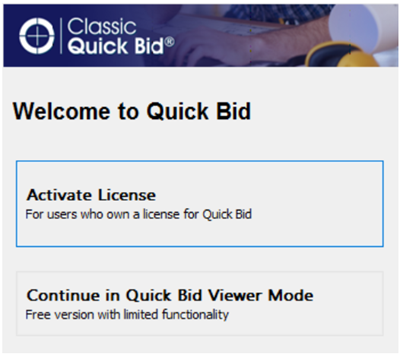
Quick Bid
Select Activate License, or, if the program is already open, click File > Check Authorization to open the licensing screen.
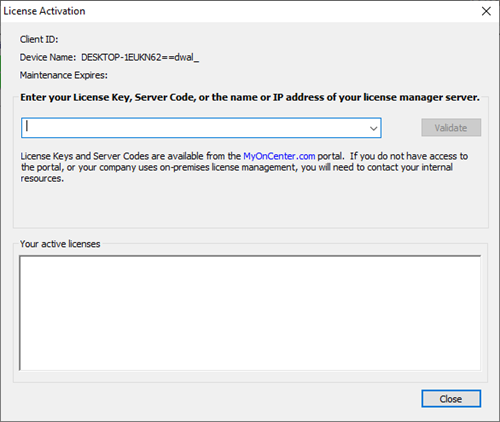
Enter your License Key or Server Code.
Click Validate
If this is a License Key, your license is activated and you can close this dialog box.
If this is a Server Code, you can opt to "borrow" a license for offline use. You may borrow a license for 7 days, but remember, that license is then unavailable to any other users, even if you close the program.
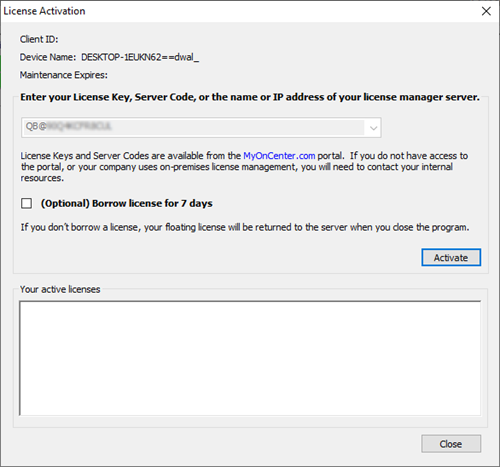
Click Activate.
Once Activated, features such as On-Screen Takeoff or Quick Bid and their product maintenance are displayed.
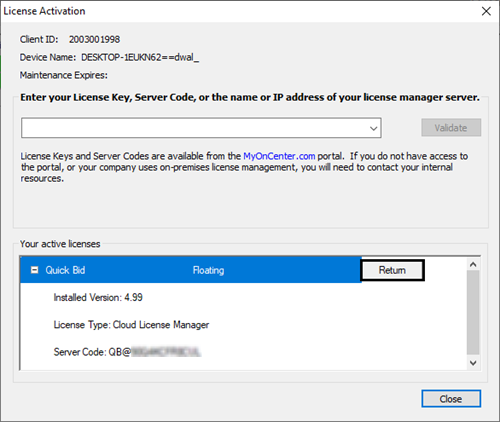
To see details about a license, click the little plus sign next to it.
Click Close to close the Check Authorization dialog and apply the license(s) to the application.
When you close the Check Authorization dialog box, your activated Features display in the bottom right of the application (the Status Bar) - this indicates that the program is properly authorized and ready to use.
Returning Your License
Let us say you activate your license on your work computer, but need to use it at home over the weekend, or a coworker needs to use it for some time. You will need to "return" your license so it can be used on a different device. Just open the Check Authorization dialog again (click File > Check Authorization) and hit the Return button next to the license detail in the lower section.
If you are using a Server Code and have not borrowed the license when you shut down the program, your license is returned to the pool automatically (the program does this in the background). Next time you launch the program, it tries to get a new license for you from the same server, again, automatically. The only time you have to "Return" a Server Code license is if you want to work in "no license" mode and let someone else use the license.
If you are using a Server Code, you must return each license feature separate (just like you have to activate them each separately).
Reactivating Previous Licenses
The programs store the last few License Keys, Server Codes, and License Managers from which you were successfully able to retrieve a license.
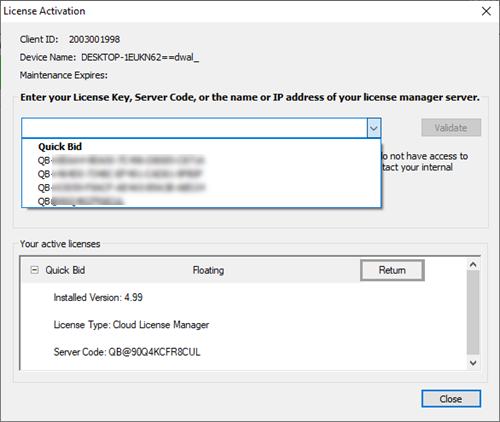
Just select whichever license you want to use and click "Validate", like usual.
Common Reasons for Authorization Failure
- Incorrect License Key or Server Code (we recommend you copy/paste - rather than trying to type these in - if possible)
- No Internet connection (always required to activate License Keys or Server Codes)
- Firewall blocking network communication (see Related articles for more information on configuring your firewall)
- Attempting to activate a License Key for a different product (you cannot activate a Quick Bid license through On-Screen Takeoff and vice versa)
- Attempting to activate an old "Activation Key" for versions released prior to 12/31/2017 - check MyOnCenter.com for your up-to-date keys
Once you've licensed the program, continue on to the next article to start a tour of Quick Bid.
The first time you launch Quick Bid 4.99.05 and newer, you are prompted to opt into Data Analytics.
If you click Yes, you'll be asked a couple additional questions. At this time, if you are a resident of California or a citizen of the European Union, we automatically opt you out of data gathering. This may change in the future, but for now, to comply with the GDPR and CCPA, we want to ensure our software meets those privacy requirements.
If you click No, and then later change your mind, you can change your opt-in settings anytime in Tools > Options > Analytics.
If you are installing an older version of Quick Bid, you are prompted to register the software the first time you run it.
This information is not shared with any 3rd parties or used for any marketing purposes.
